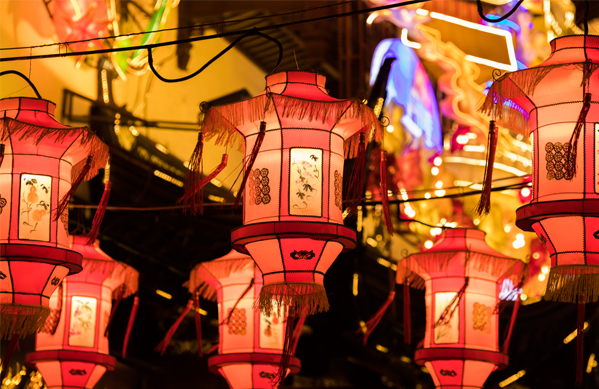Lanterns celebrate the first full moon of the year

A lantern fair on the night of the Lantern Festival in China Photo: 699PIC
Why the 15th day of the first lunar month is called the Lantern Festival is still uncertain. Confucianism, Taoism and Buddhism, which constitute the essence of traditional Chinese culture, contain different interpretations of the Lantern Festival.
The Taiping Yulan (or Imperial Readings of the Taiping Era, a massive Chinese encyclopedia compiled from 977 to 983) quotes the Shiji (Records of the Grand Historian) as saying that Emperor Wudi of the Han Dynasty worshiped Taiyi (the God of Heaven) on that day and that this ceremony lasted throughout the night. The Taiping Yulan notes that the admiration and enjoyment of lanterns on the night of the 15th day of the first lunar month today is an inheritance that has been passed on from Emperor Wudi. Associating the origin of the Lantern festival with the worship of Taiyi is a Confucian interpretation.
A legend associates the festival with Taoism by linking to the birthday of Tianguan (a Taoist god responsible for good fortune), which falls on the 15th day of the first lunar month. Therefore, followers prepare lanterns on that night to pray for good fortune.
The roots of the festival are also popularly linked to the reign of Emperor Mingdi of the Han Dynasty when Buddhism was growing in China. Dasong Sengshi Lüe (A Brief History of Monks in the Song Dynasty) quotes Gaoseng Zhuan (Biographies of Eminent Monks) as saying that events commemorating the Buddha’s displaying miracles for his disciples fell on the 15th day of the first lunar month. Therefore, Emperor Mingdi ordered the lighting of lanterns on that day, and he visited a temple to light a lantern himself. This practice began to circulate and grow, and the Tang Dynasty also adopted it.
Festivals were deeply rooted in the lives of ancient people and kept evolving as civilizations developed. It is hard to find out the true origins of the Lantern Festival, but evidence shows that lighting lanterns didn’t become a custom until the Tang Dynasty. Historical texts show that the celebrations of this festival were not lacking in live music, dance performances and delicious food, but lanterns and their appreciation have always played a leading role.
Among all the lanterns displayed in the festival, jiuhua lanterns, or nine-hued lanterns, may be the most gorgeous. A passage of Shuihu Zhuan (Water Margin), an ancient Chinese vernacular novel, mentions that bandit-heroes captured a group transporting lanterns for the Eastern Capital (present-day Kaifeng in Henan Province). The lanterns they were transporting were nine-hued lanterns. The captured bailiff confessed, “Every year the capital orders three sets of lanterns from our prefecture … The lanterns are the Jade Shed Intricate None-Hued type.” “The artisans hung the Jade Shed lanterns, a total of eighty-one, on four sides. Suspended in Loyalty Hall, they extended from the rafters to the floor.” Suishi Guangji (or Vast Records of the Annual Seasons, an overview of the imperial edicts concerned with the seasons by the Song-Dynasty scholar Chen Yuanjing) quotes the Xijing Zaji (Miscellaneous Records of the Western Capital) as depicting the jiuhua lanterns illuminating the Zhongnan Mountains on the night of the 15th day of the first lunar month, lighting up a distance of over one hundred li (a Chinese unit of distance which equals 500 meters) around the lanterns. Although “lighting up over one hundred li” is an exaggeration, these texts give us a glimpse of the charm of the jiuhua lanterns.
Jade lanterns were known for their elegance. Wulin Jiushi (or Ancient Matters From Wulin Garden, a Song period description of Lin’an, a city in present-day Hangzhou in Zhejiang Province) mentions that the jade lanterns offered by the Fuzhou (in present-day Fujian Province) government as tribute were made of white jade, dazzling with brilliancy, and were as pure as jade bottles, which were pleasantly fresh. Liuli, a type of colored decorative glass prevalent in ancient China, was also admired as a material for lanterns for its similarities with jade. During the Song Dynasty, the lanterns offered by the Xin’an (in present-day Henan Province) government were called Boneless Lanterns, because they were made of liuli instead of the usual wooden frames. It is recorded that these lanterns were formed by using silk sachets, which were filled with millet, as moulds. The millet was removed after the melted liuli was shaped, leaving a hollow liuli ball.
Another distinctive type was the ice lantern. It is recorded that ice was carved into sculptures including the figures of people, flowers, birds, insects and animals. Craftsmen used special treatments to prevent the ice from melting over a couple of days.
The silk lanterns were known for the paintings on their covers. These lanterns were covered with smooth silk, a good material for drawing and writing. In the end, these lanterns became notable examples among the painting and calligraphic arts.
The article was edited and translated from Chinese Art News.
edited by REN GUANHONG
